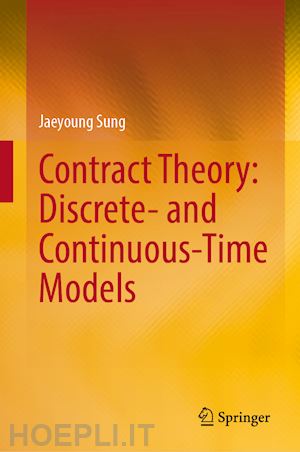

Questo prodotto usufruisce delle SPEDIZIONI GRATIS
selezionando l'opzione Corriere Veloce in fase di ordine.
Pagabile anche con Carta della cultura giovani e del merito, 18App Bonus Cultura e Carta del Docente
This book provides a self-contained introduction to discrete-time and continuous-time models in contracting theory to advanced undergraduate and graduate students in economics and finance and researchers focusing on closed-form solutions and their economic implications. Discrete-time models are introduced to highlight important elements in both economics and mathematics of contracting problems and to serve as a bridge for continuous-time models and their applications. The book serves as a bridge between the currently two almost separate strands of textbooks on discrete- and continuous-time contracting models
This book is written in a manner that makes complex mathematical concepts more accessible to economists. However, it would also be an invaluable tool for applied mathematicians who are looking to learn about possible economic applications of various control methods.
Introduction.- Incentive Problems.- Basic Structures of Contracting Problems.- Discrete-Time Formulation I.- Discrete-Time Formulation II.- Contracting in Continuous Time: Time-Multiplicative Preferences.- Optimal Performance Metrics.- Contracting under Incomplete Information.- Career Concerns in Competitive Executive Job Markets.- Agency Problem in Weak Formulation.- Contracting with a Mean-Volatility Controlled Outcome.- Hierarchical Contracting: A Mean-Volatility Control Problem.- Contracting in Continuous Time: Time-Additive Preferences.- Contracting under Ambiguity: Introduction.- Contracting under Ambiguity in Continuous Time.- Information Asymmetry: Hidden Information.- Information Asymmetry: Adverse Selection.- Information Asymmetry: Adverse Selection and Moral Hazard.
Jaeyoung Sung is currently Professor Emeritus of Finance at Ajou University, South Korea. He served as principal investigator of the WCU (World Class University) project to establish a world-class financial engineering program at Ajou University. He also taught at University of Illinois at Chicago, and he was visiting professor at Washington University in St. Louis, University of New South Wales, and University of Southern California. His research interests lie in agency theory, asset pricing and market microstructure. He has published on continuous-time agency problems in economics and finance journals such as Journal of Economic Theory, Rand Journal of Economics, Review of Financial Studies, Mathematical Finance, and others.











Il sito utilizza cookie ed altri strumenti di tracciamento che raccolgono informazioni dal dispositivo dell’utente. Oltre ai cookie tecnici ed analitici aggregati, strettamente necessari per il funzionamento di questo sito web, previo consenso dell’utente possono essere installati cookie di profilazione e marketing e cookie dei social media. Cliccando su “Accetto tutti i cookie” saranno attivate tutte le categorie di cookie. Per accettare solo deterninate categorie di cookie, cliccare invece su “Impostazioni cookie”. Chiudendo il banner o continuando a navigare saranno installati solo cookie tecnici. Per maggiori dettagli, consultare la Cookie Policy.